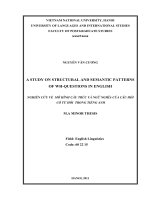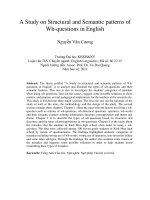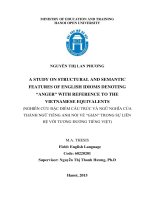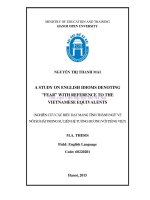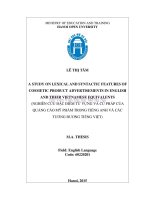A study on structural and semantic features of english idioms denoting anger with reference to the vietnamese equivalents
Bạn đang xem bản rút gọn của tài liệu. Xem và tải ngay bản đầy đủ của tài liệu tại đây (896.06 KB, 82 trang )
MINISTRY OF EDUCATION AND TRAINING
HANOI OPEN UNIVERSITY
NGUYỄN THỊ LAN PHƯƠNG
A STUDY ON STRUCTURAL AND SEMANTIC
FEATURES OF ENGLISH IDIOMS DENOTING
“ANGER” WITH REFERENCE TO THE
VIETNAMESE EQUIVALENTS
(NGHIÊN CỨU ĐẶC ĐIỂM CẤU TRÚC VÀ NGỮ NGHĨA CỦA
THÀNH NGỮ TIẾNG ANH NÓI VỀ “GIẬN” TRONG SỰ LIÊN
HỆ VỚI TƯƠNG ĐƯƠNG TIẾNG VIỆT)
M.A. THESIS
Field: English Language
Code: 60220201
Supervisor: Nguyễn Thị Thanh Hương, Ph.D
Hanoi, 2015
NGUYEN THI LAN PHUONG
Front hard paper cover
Back hard paper cover
FIELD: ENGLISH LANGUAGE
2013-2015
27
CERTIFICATE OF ORIGINALITY
I, the undersigned, hereby certify my authority of the study project report
entitled “A study on structural and semantic meaning of English Idioms
denoting anger with reference to the Vietnamese equivalents” submitted in
partial fulfillment of the requirements for the degree of Master in English
Linguistics. Except where the reference is indicated, no other person’s work has
been used without due acknowledgement in the text of the thesis.
Hanoi, 2015
Nguyen Thi Lan Phuong
Approved by
SUPERVISOR
Nguyen Thi Thanh Huong
Date:……………………
i
ACKNOWLEDGEMENTS
This thesis could not have been completed without the help and support
from a number of people.
First and foremost, I would like to express my sincere gratitude to
Nguyen Thi Thanh Huong PhD, my supervisor, who has patiently and
constantly supported me through the stages of the study, and whose stimulating
ideas, expertise, and suggestions have inspired me greatly through my growth
as an academic researcher.
My special word of thanks goes to all the lecturers at the Faculty of Post
Graduate Studies - Ha Noi Open University for their interesting lectures and useful
advice. I would also like to thank my colleagues and friends for idea sharing and
encouragement. It would never have been possible for me to have this thesis
accomplished without all of these valuable supports.
Last but not least, I am greatly indebted to my family for the sacrifice
they have devoted to the fulfillment of this academic work.
ii
ABSTRACT
Idioms play an important role in all natural languages including English and
Vietnamese. They enrich the language. They help speakers and writers to
emphasise their ideas and make our observations, judgments, and explanations
more lively and interesting. They are also very useful tools for communicating
a great deal of meaning in a few words. Effective communication cannot be
achieved successfully without idioms.
Idioms are considered not only to be able to enrich the language, by helping
speakers and writers to emphasise their ideas, make their judgments, and
explanations more lively and interesting, but also to be very useful tools for
communicating meaningful ideas in a condensed expressions. Effective
communication cannot be achieved successfully without idioms; therefore, they are
worth studying
Idioms, a very important aspect of language, add colour to the
language, helping us to emphasise meaning and to make our observations,
judgments, and explanations lively and interesting. They are also very useful
tools for communicating a great deal of meaning in just a few words.
The aim of this thesis is to contribute a comprehensive account of
structural and semantic features of English Idioms denoting “anger” with
reference to the Vietnamese equivalents. Finally, some suggestions are put
forward for English idiom denoting “anger” for teaching and learning.
iii
LIST OF ABBREVIATIONS
N
: Noun
V
: Verb
Adj
: Adjective
Adv
: Adverb
Prep
: Preposition
NP
: Noun Phrase
VP
: Verb Phrase
Adj.P
: Adjective phrase
Adv.P
: Adverbial Phrase
PP
: Prepositional Phrase
iv
LIST OF TABLES
Table 1: English and Vietnamese idioms denoting “anger” in terms of
structural features
32
Table 2.Comparison of English and Vietnamese idioms denoting
“anger” in terms of semantic features
48
v
TABLE OF CONTENTS
Certificate of originality
i
Acknowledgements
ii
Abstract
iii
List of abbreviations
iv
List of tables and figures
V
Chapter 1: INTRODUCTION
1
1.1.
Rationale for the research
1
1.2.
Aims of the research
2
1.3.
Objectives of the research
2
1.4.
Scope of the research
2
1.5.
Significance of the research
3
1.6.
Structural organization of the thesis
3
Chapter 2: LITERATURE REVIEW
5
2.1. Review of previous studies
5
2.1.1. Previous studies overseas
5
2.1.2. Previous studies in Vietnam
6
2.2. Review of theoretical background
7
2.2.1. Theoretical framework
7
2.2.2. Theoretical background
9
2.2.2.1. Definitions of idioms
10
2.2.2. 2. Idioms versus proverbs, sayings, conventional phrases and
11
phrase verbs
2.2.2.3. Features of English Idioms
12
vi
2.2.2.4. Classification of English idioms
15
2.2.2.5. Idioms of anger
18
2.2.2.6. Summary
21
Chapter 3: METHODOLOGY
3.1.
Research-governing orientations
23
3.1.1. Research questions
23
3.1.2. Research setting
23
3.1.3. Research approach
24
3.1.4. Criteria for intended data collection and data analysis
24
3.2.
24
Research methods
3.2.1. Major methods versus supporting methods
25
3.2.2. Data collection techniques
25
3.2.3. Data analysis techniques
26
3.3. Summary
26
Chapter 4: FINDINGS AND DISCUSSIONS
28
4.1.
Structures features of English idioms denoting “anger” with
28
reference to the Vietnamese equivalents
4.1.1.
Similarities
28
4.1.1.1. Idioms patterns
28
4.1.1.2. Simile
30
4.1.2.
31
Differences
4.1.2.1 Idioms patterns
31
4.1.2.2 Fixedness of form
33
4.2.
Semantic features of English idioms denoting “anger” with
39
reference to the Vietnamese equivalents
4.2.1.
Similarities
39
vii
4.2.1.1. Lexical variability
39
4.2.1.2. Metaphors and metonymies
40
4.2.2.
51
Differences
4.2.2.1. Metaphors and metonymies
51
4.2.2.2. Third suffering
53
4.2.2.3. Cultural origin of idioms
54
4.3
55
Implication for teaching and learning English idioms denoting
“anger “
4.3.1.
Structural features of idioms
56
4.3.2.
Semantic features of idioms
56
4.3.3.
Using games
59
4.4.
Summary
60
Chapter 5: CONCLUSION
61
5.1.
Recapitulation
61
5.2. Concluding remarks
61
5.3. Limitations of the research and suggestions for further studies
62
REFERENCES
63
APPENDICES
67
viii
Chapter 1
INTRODUCTION
1.1.
Rationale for the research
There was a time when effective communication was measured by the
number of words one could express in a certain period of time. But as we are living
in the 21st century, effective communication now means less words but more
meanings. In this sense, idioms are a perfect match. They are very useful tools
for communicating a great deal of meaning in a few words. Nowadays,
effective communication cannot be achieved successfully without idioms.
Idioms have long been considered rare exceptions to the literal norms
of language and difficult for foreign learners to understand and use. However,
as they are often found to be the most natural and appropriate expressions to
use in daily discourse, they become so basic to a language that a language
learner must master them in order to be competent in the language. The
importance of idioms is well supported by the argument that the fundamental
roots of human language and thought are figurative and idioms are the most
pervasive actualization of the creative nature of human expression.
Every language has its own collection of idioms, so does English. In
reality, English language is full of idiomatic expressions and once a native
English speaker gets talking, he never stops to think about idioms; they have
become a natural part of his conversation skills. However, English idioms are
relatively neglected in those education systems whose English is thought as
the second language because it’s very challenging to learners while many
second –language teachers are not completely immersed in the language so
they do not know the true conversational idioms. As a result, there is a lack of
understanding and knowledge about English idioms by a majority of learners,
herein Vietnamese learners.
1
1.2.
Aims of the research
The graduation thesis is conducted with a view to help Vietnamese
learners to acquire a better understanding of structural and semantic features
of English Idioms denoting anger with reference to the Vietnamese
equivalents, as well as to improve their ability of using them to avoid
communication breakdown.
1.3.
Objectives of the research
This thesis is carried out to pursue these following specific objectives:
- Investigating the structural features of English idioms denoting ANGER
with reference to the Vietnamese equivalents.
-Investigating the semantic features of English idioms denoting ANGER
with reference to the Vietnamese equivalents.
-Suggesting some possible suggestions for teaching and learning English
idioms denoting “anger” in an effective way.
1.4.
Scope of the research
Idioms are a conspicuous type of conventional expressions. They
frequently suggest the particular emotion or attitude of the person using
them. It is well-known that there are many kinds of idioms, idioms of
emotions, animals, and colours, etc. A study shows that there are 433 idioms
of emotions in Cambridge International Dictionary of Idioms, out of which
as many as 105 are used to express anger. Dictionary of idioms (1996) lists
111 idioms of anger. They form the largest group of figurative idioms of
emotions in the English language. In this paper, I only focus on the idioms
expressing anger as they reflect most of the characteristics of English
idioms., Their similarities and differences in comparison with Vietnamese
2
equivalents are also highlighted.
1.5.
Significance of the research
This study is conducted by carefully collecting materials from various
sources to have full-blown information of idioms, their characteristics in
general and idioms of anger in particular. Systematically statistic and
contrastive analysis are also used to find out similarities and differences of
English and Vietnamese idioms of anger. Frequent talks with my supervisor
and lecturers have proved to be very useful. Some of my personal knowledge
and experience in teaching and learning also contribute to the completion of
the thesis.
1.6.
Structural organization of the thesis
This thesis consists of five chapters: Introduction, Literature,
Methodology, Findings and Discussion, and Conclusion.
Chapter 1 - “Introduction” - presents a brief account of relevant
information for carrying out the study such as the rationale for selecting the
topic, the aims, the objectives, the scope, the significance and the structure of
the thesis.
Chapter 2 - “Literature Review” - presents the overview of the
previous researches related to the thesis topic and covers a series of idiomrelated concepts such as: definitions of idioms, features of English idioms,
types of English idioms, idioms in comparison with proverbs, the
relationship between idioms and culture, classification of idioms.
Chapter 3 - “Methodology” - provides a full description of the specific
methods and techniques which are applied to conduct the thesis research.
3
Chapter 4 - “Findings and discussion” - describes and analyses the
structural and semantic features of English idioms denoting “anger” with
reference to the Vietnamese equivalents.
Chapter 5 - “Conclusions and implications” - summaries the major
findings resulted from the investigation and data analysis, presents the
limitations of the study, proposes possible implications for teaching and
learning English idioms denoting “anger” effectively, and provides some
recommendations for further research on this important subject.
4
Chapter 2
LITERATURE REVIEW
The literature review serves two main purposes. Firstly it gives a
review of previous studies related to English idioms in general and English
idioms denoting “anger” in particular. Secondly it presents and discusses the
theoretical background which guides and plays as the foundation for this
research thesis to base on in the process of conducting the whole research.
2.1
Review of previous studies
2.1.1 Previous studies overseas.
Idioms are a broad and crucial field of any languages. Thus, they have
attracted linguistics all over the world and there is no doubt that a
considerable number of books and dictionaries on idioms have brought
learners with great benefits.
In the book “Idiom Structure in English” (Makkai, 1972), the concept
of idiomaticity areas is introduced and the membership of each is illustrated
with a small number of typical examples. Each type of idiom in the first
idiomaticity area (lexemic system) and the second idiomaticity area (sematic
system) is described in terms of its internal structure and assigned a label.
This discussion of the idiomaticity areas and their membership is integrated
with a general definition of the idiom in both the lexicology and the
semiology. By describing these two idiomaticity areas, the author suggests a
framework by which all types of English idioms have been mentioned.
The central argument of Rosamund Moon in “Fixed Expressions and
Idioms in English: A Corpus-based Approach” (1998) is that fixed
expressions can only be fully understood if they are considered together with
the texts in which they occur. She provides an overview of this area of lexis
5
in current English. Writing from a lexicological rather than a computational
point of view, she gives a detailed, descriptivist account of the findings of
research into several thousand fixed expressions and idioms, as evidenced in
the corpus text, including information about frequencies, syntax, lexical
forms and variations and metaphoricality. She also argues that examination
of corpus text raises questions about many received ideas on fixed
expressions and idioms, and suggests that new or revised use-centered
models are required. Later chapters of the book demonstrate the ideological
and discoursal significance of idioms, paying particular attention to the ways
in which they convey evaluations and have roles with respect to the
information structure and cohesion of texts.
“Idioms and Idiomaticity” by Chitra Fernando (1996) provides a
comprehensive treatment of idioms and idiomaticity from a functional
perspective. It examines the use of idioms in discourse to combine the novel
and the conventional, to convey representations of the world, evaluate people
and situations, signal conviviality or conflict, and create coherent, cohesive
texts. This book goes on to consider implications for language learning and
development.
“Idioms: Description, Comprehension, Acquisition, and Pedagogy” by
Dilin Liu (2008) supplies comprehensive, up-to-date, and accessible text on
idiom use and suggests learning and teaching approaches.
2.1.2 Previous studies in Vietnam
In Vietnam, Nguyễn Lực, Lương Văn Đang [53] are two authors who
made a significant contribution in the field of Vietnamese idioms. They
wrote “Thành ngữ Tiếng Việt” which is a collection of Vietnamese idioms
arranged in alphabetical order with clear explanations and examples
extracted from Vietnamese novels, newspapers and magazines. Moreover,
6
Nguyễn Trần Trụ who wrote “Thành ngữ tục ngữ lược giải” [59] explains
meanings of the most common idioms and proverbs in such simple, clear
ways that learners can use this book for consulting and reference purposes.
Despite the fact that idioms human beings are an extremely common
part of the normal everyday language use, it is still a largely neglected area
in scholarly studies. So far, no studies dealing with the structural and
semantic features of English idioms denoting “anger” with reference to the
Vietnamese equivalents have been found. Therefore, this research is being
implemented to find the above-mentioned features, hence proposing some
possible applications for teaching and learning English anger-related idioms.
2.2 Review of theoretical background
2.2.1 Theoretical framework
The basic characteristic of idiomatic expressions is that the words are
used metaphorically. Therefore, the surface structure has a little role to play
in understanding the meaning of the whole expression. According to
Johnson-Laird (1993), “idioms are illogical and frustrating features of
discourse since their meanings do not depend on the meaning of their parts
and the syntactic relations for those parts”.
Vinogradov (1977) compares the meaning of an idiom with “the
special chemical mixture” which is partially or completely new compared
with the meaning of all the components. This means that the meaning of an
idiom can rarely be drawn from its components and it is very important to
understand idioms metaphorically. Learners of English cannot usually
discover the meanings by looking up the individual words in a dictionary
when studying idioms; most of the idioms are metaphorical rather than
literal. For example, in order to understand the idiom “(to feel) like fish out
of water”, we have to consider its meaning metaphorically as “to feel
7
uncomfortable because of unfamiliar surroundings”. Consequently, the
first notice of English idioms is their semantic opacity or their figurative
sense and non-literalness by another term. Semantic opacity means that
idioms are often non-literal. Hence, the individual words which make up
the idiom do not carry any meaning of their own. There is usually very
little, if any, connection between the literal meanings of the individual
words and the idiomatic meaning of the whole phrase (Fernando 1996:
61). Makkai (1972: 118) states that the meaning of an idiom is not
predictable from its component parts, because they are used in a
figurative, non-literal sense. Non-literalness is also in central place in
Strässler’s (1982: 79) idea of an idiom.
According to Strässler, the
meaning of an idiom cannot be concluded by adding up the meanings of
its constituents. The meaning of an idiom is therefore hardly ever the sum
of its individual parts. Semantic opacity seems rather crucial for idioms,
seeing as the scholars quoted here are only some of the many who
recognize semantic opacity or non-literalness as an essential feature of
idioms. However, some idioms whose literal meaning and figurative one is
almost identical so that readers or listeners can guess the meaning. For
example, the idiom ‘as bald as an egg’ seems to make no difficulty for
readers or listeners to deduce its meaning.
Semantic unity can perhaps be considered as the second most
frequently mentioned feature of idioms. Although idioms are nearly
always multiword expressions, they sometimes function as single
semantic units. Cowie and Mackin (1994) therefore stress that idioms are
“units of meaning” – a fact that distinguishes them from non-idiomatic
expressions, which consist of distinct meaningful components.
A large number of idioms in English, and probably all languages,
have both a literal and an idiomatic meaning. In consequence, another
8
feature of idioms which is mentioned rather often in theoretical literature
is ambiguity or disinformation potential. According to Weinreich (1969:
44), ambiguity is one of the most fundamental features of idioms: this
ambiguity arises from the fact that the constituents of an idiom have
literal equivalents in other contexts. In addition, in Makkai’s (1972)
definition of an idiom this ambiguity is in extremely central place.
Makkai claims that true idioms must carry disinformation potential (i.e. be
ambiguous), and this is one of his salient criteria for identifying idioms.
Makkai argues that idioms are often subject to “a possible lack of
understanding despite familiarity with the meaning of the components”.
In Makkai’s view this “disinformation” occurs when the composition of
the idiom leads the individual to understand the expression in a logical but
erroneous way. “Go Dutch” (go to Holland) and “For a song” (about
singing) illustrate this point clearly because they often mislead readers and
listeners with their literal meaning.
Collocability is also mentioned in some idiom characterizations,
though not as
frequently as the above-mentioned characteristics.
Collocability refers to the tendency of words to co-occur. In fact, idioms
have come to existence precisely because of this tendency. Fernando
(1996: 31) points out that collocability very often gives rise to idiomatic
expressions, but obviously not all of these expressions become idioms.
According to Weinreich (1969, as cited by Fernando 1996: 7), the cooccurrence of words is a feature which is present in both collocations and
idioms, but in an idiom this co-occurrence of words results in “a special
semantic relationship”, which separates them from collocations.
2.2.2. Theoretical background
2.2.2.1. Definitions of idioms
9
Fernando
(1996:3)
defines
idioms
as
being
a
type
of
“conventionalized multiword expressions”, and “individual units whose
components cannot be varied or varied only within definable limits” and
“not usually recombinable” (1996:30), as well as referring only to “those
expressions which become conventionally fixed in a specific order and
lexical form, or have a restricted set of variants, acquire the status of idioms
and are recorded in idiom dictionaries”. Jennifer Seidl and W McMordie
(1978:4) share the same point of view with Hornby (Oxford Advanced
Learner’s Dictionary, 1995) and Longman Idioms Dictionary (1998) and
give the definition: “An idiom is a number of word which, taken together,
mean something different from the individual words of the idiom when they
stand alone”.
Collins Cobuild (1995) defines: ‘An idiom is a special kind of phrase.
It is a group of words which have a different meaning when used together
from the one it would have if the meaning of each word were taken
individually…Idioms are typical metaphorical: they are effectively
metaphors which have become ‘fixed’ or ‘fossilised’.
To put it simply, an idiom is a fixed expression whose meaning
cannot be taken as a combination of the meanings of its component parts.
Thus, the common phrase “kick the bucket” has nothing to do with either
“kicking” or “buckets”, but means simply, “to die.” In other words, idioms
are not literal expressions. They are also fixed expressions, to the extent that
the elements which make up the idioms are limited in the kinds of
variability they are able to demonstrate.
10
It is difficult if not impossible to reach an agreement on the definition
of an idiom as many scholars attempt to define and develop their own
criteria and classification of idioms.
2.2.2.2. Idioms versus proverbs, sayings, conventional phrases and
phrasal verbs
An idiom is an expression that contains more than one word, and
whose meaning is different from the sum of the literal meanings of its
components. Excluded, however, are proverbs, sayings and conventional
phrases. Although they are all multi-word expressions that often mean
something different from the words in them, they each form a category of
their own depending on the function they have. Proverbs are short wellknown statements that give advice or express something that is generally
true (Longman Exams Dictionary). They often carry some additional
meanings, or their purpose is to teach a lesson, and they are somehow more
tightly connected with cultural discourse. For example ‘The early bird
catches the worm’ means arriving early gives one an advantage or ‘money
doesn’t grow on trees’ - money is not easy to get and you must work hard. A
saying, which is a well-known short statement that expresses an idea most
people believe is true and wise, can be considered to be closed to idioms,
but it is usually not figurative, e.g. You can’t judge a book by its cover, as
the old saying goes. Thirdly, conversational phrases have a special
interactional function, and they are often literal rather than metaphorical, for
example ‘God be with you’. Finally, a phrasal verb is a verb which is a
combination of a verb and a particle (hand in), a verb and a preposition
(congratulate on, refer to), and a verb with a particle and a preposition (run
away with, send out to). It can have a literal meaning that is easy to
understand because the meaning is clear from the words that are used in the
phrasal verb itself. It can also have an idiomatic meaning which cannot
11
easily
be
understood
by
looking
at
the
words
themselves.
The figure below illustrates the fuzziness of the boundaries between various
multi-word expressions (Moon, 1998).
FIGURATIVE
metaphorical usage of
single words
idioms
proverbs
sayings
LITERAL
single words
collocations
FIGURE 1:
phrases
The rough field of vocabulary
2.2.2.3 Features of English Idioms
a) Structural features
Jennifer Seidl and W. McMordie (1978:5) give some special features of
English idioms as follows:
Idioms take many different forms or structures. They can be very
short or rather long. A large number of idioms consist of some combination
of a noun and an adjective, e.g. cold war, a dark horse, French leave, forty
winks, a snake in the grass. Some idioms are much longer: to fish in
troubled waters, to take the bull by the horns, to cut one’s coat according to
one’s cloth.
An idiom can have a regular, an irregular or even a grammatically
incorrect structure. The idiom “I am good friends with him” is irregular or
logical in its grammatical structure. A native speaker is not consciously
aware of this insistency because the form is irregular but the meaning is
clear. A second kind has a regular form but a meaning is not clear, for
example “to have a bee in one’s bonnet”. There is a third group, in which
both form and meaning are irregular, such as “to be at large”, “to go
12
through thick and thin”. The form Verb + Preposition + Adjective without
noun is strange in English. Here are some examples: “to be at daggers
drawn”, “to be in the swim”…
Some idioms are unique and fixed in their grammatical structure, which
cannot change any part at all. The expression to sit on the fence cannot
become to sit on a fence or to sit on the fences. They are fixed idioms. Some
are fixed in some of their parts but not in others. Some idioms allow only
limited changes in the parts which are not fixed. Such as nouns, pronouns or
the verb tenses as in: ‘I sat on the fence and did not give my opinion’ and
Many people are sitting on the fence and do not want to give their opinion.’
It is for these reasons that it is sometimes difficult to isolate the actual
idiomatic expression and find it in a dictionary of idioms.
According to A.P Cowie, R Martin and I.R McCaig, the authors of
Oxford Dictionary of English Idioms, there are enormous structural varieties
of English idioms, which can be classified under two general headings:
phrase idioms and clause idioms. Within these major groupings are several
dominant sub-categories. Besides these two main types, there is also another
type of idioms even though it does not account for a large percentage. That
is sentence idioms. The most common patterns are the following:
Clause idioms
Verb + Complement: go banana, go berserk…
Verb + Direct Object: ease one’s conscience/mind…
Verb + Direct Object + Complement: paint the town red…
Verb + Indirect Object + Direct Object: do somebody credit...
Verb + Direct Object + Adjunct: take something amiss…
An important grouping of clause idioms is identified by the
grammatical code ‘possessive’. These idioms make full use of the verbs get,
13
give and have as ordinary non-idiomatic sentences concerned with
ownership or change of ownership. There are two most common patterns
Verb + Direct Object: get a fair share of the cake, get a bad name…
Verb + Indirect Object + Direct Object: give someone a taste of their own
medicine; give someone a quick shot in the arm…
Phrase idioms
Noun phrase: a crashing bore…
Adjective phrase: free with one’s money…
Prepositional phrase: in the nick of time…
Adverbial phrase: as often as not…
Sentence idioms
Sentence idioms may be simple or complex sentences such as one
swallow does not make a summer, give somebody an inch and he’ll take a
mile, one’s blood is up, the knives are out…
b) Semantic features of idioms
To tell whether a multi word unit is an idiom or not, only the
knowledge of the range that idioms cover is not enough. Many scholars in
the past turned to the semantic features that idioms characterize in order to
distinguish idioms from habitual restricted multiword expressions. Semantic
unity or non-compositionality is considered as the most salient feature of
idioms (Fernando, 2000). Other frequently mentioned semantic features of
idioms are institutionalization or conventionality and figuration.
Non-compositionality: Compositionality relates to meaning. The
meaning of a construction is compositional if it is derived transparently from
the meaning of its elements. Non-compositionality thus means the meaning
of the construction is not the sum of the meanings of its parts. For example,
‘spill the beans’ has nothing to do with beans but means ‘commit an
14
indiscretion'. Idioms are widely defined as being non-compositional (Katz
& Postal, 1963; Weinreich, 1969; Makkai, 1975; Fernando & Flavell, 1981),
partly compositional (Ruhl, 1975), for example ‘catch one’s breath’
(check), ‘foot the bill (pay).The last one is compositional after the meaning
is known (Nunberg et al., 1994), for example ‘on foot’, ‘on the contrary’.
Institutionalization: It refers to the degree of recognition a particular
phrase meets in a speech community. The conventionality of this expression
has resulted in its currency and acceptance among the wider discourse
community rather than by a small sub- community. Some institutionalized
utterances are lexicalized and serve as conversational routines or social
formulae such as greetings, ending a telephone conversation, saying
goodbye, etc., e.g. nice to meet you, so long, have a nice weekend, take care
now, come off it. Idioms are thus widely recognized and familiar to speakers
of a particular culture (Fernando & Flavell, 1981; Moon, 1998a).
Figuration: some idioms typically involve metaphors (a drop in the
bucket), metonymies (lend a hand), hyperboles (eat one’s head off), or other
kinds of figuration. Native speakers usually take no effort to figure out their
figurative meanings from their literal senses.
It is believed that non-compositionality, institutionalization and
figuration are related. It is also argued that something which is noncompositional cannot be produced simply as a sequence of words but must
be held in memory. In other words, it becomes institutionalized and is held
in
memory
to
survive.
Non-compositionality
depends
on
prior
institutionalization. In addition, not all idioms are involved in figuration.
Thus, non-compositionality is the key criterion to define idioms (Grant &
Bauer, 2004).
2.2.2.4 Classifications of English idioms
15



